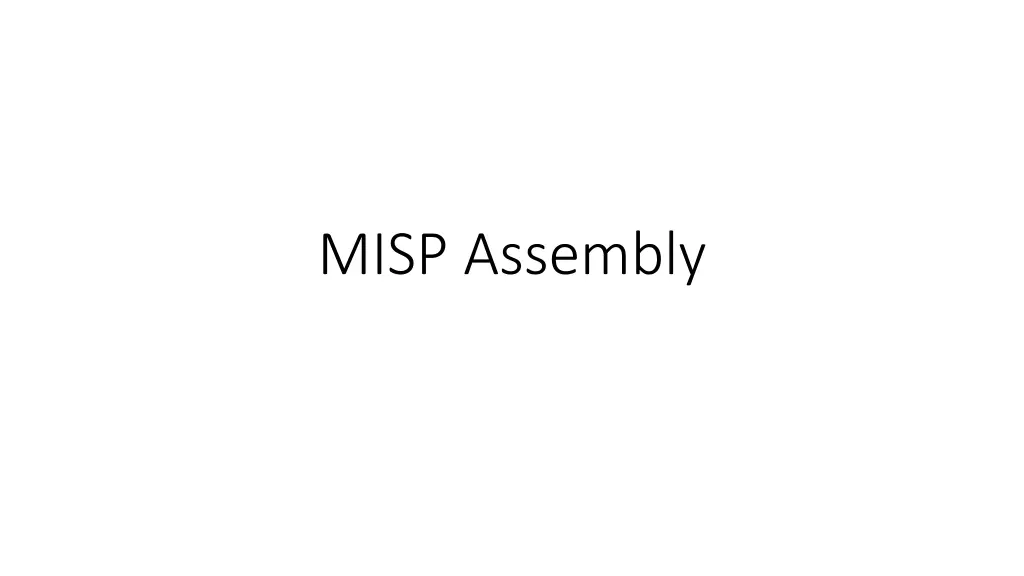
Logical and Bit-wise Operations in MIPS Assembly
Learn about constant or immediate operands, logical operations (AND, OR, XOR), and bit-wise operations (AND, OR, XOR) in MIPS assembly language. Discover how to apply logical and bit-wise operations efficiently to manipulate data at the bit level. Explore the use of constants, logical operators, and bitwise operators to perform various computations in MIPS architecture.
Download Presentation

Please find below an Image/Link to download the presentation.
The content on the website is provided AS IS for your information and personal use only. It may not be sold, licensed, or shared on other websites without obtaining consent from the author. If you encounter any issues during the download, it is possible that the publisher has removed the file from their server.
You are allowed to download the files provided on this website for personal or commercial use, subject to the condition that they are used lawfully. All files are the property of their respective owners.
The content on the website is provided AS IS for your information and personal use only. It may not be sold, licensed, or shared on other websites without obtaining consent from the author.
E N D
Presentation Transcript
Constant or Immediate Operands Many times we use a constant in an operation For example, i++, i--, i += 4, and so on Since constant operands occur frequently, we should include constants inside arithmetic operations so that they are much faster MIPS has an add instruction that allows one operand to be a constant The constant must be in 16 bits, as a signed integer in 2 s complement format addi $s1, $s2, 100 # $s1 = $s2 + 100 6/4/2025 CDA3100 2
Logical Operations Often we need to operate on bit fields within a word. Which allow us to pack and unpack bits into words and perform logical operations such as logical and, logical or, and logical negation 6/4/2025 CDA3100 3
Logical operations And: 0 and 0 = 0, 0 and 1 = 0, 1 and 0 = 0, 1 and 1 = 1 Or: 0 or 0 = 0, 0 or 1 = 1, 1 or 0 = 1, 1 or 1 = 1 Xor: 0 xor 0 = 0, 0 xor 1 = 1, 1 xor 0 = 1, 1 xor 1 = 0
Bit-wise AND Apply AND bit by bit The resulting bit is 1 if both of the input bits are 1 and zero otherwise and $t2, $t0, $t1 There is also a version of AND with an immediate andi $t2, $t1, 12 The immediate is treated as an unsigned 16-bit number 6/4/2025 CDA3100 5
Bit-wise OR Apply OR bit by bit The resulting bit is 1 if at least one of the input bits is 1 and zero otherwise or $t2, $t0, $t1 There is also a version of OR with an immediate ori $t2, $t1, 12 The immediate is treated as an unsigned 16-bit number 6/4/2025 CDA3100 6
Bit-wise XOR Apply XOR bit by bit The resulting bit is 1 if two bits are different xor $t2, $t0, $t1 There is also a version of OR with an immediate xori $t2, $t1, 12 The immediate is treated as an unsigned 16-bit number 6/4/2025 CDA3100 7
NOR Since NOT takes one operand and results in one operand, it is not included in MIPS as an instruction Because in MIPS each arithmetic operation takes exactly three operands Instead, NOR is included The resulting bit is 0 if at least one of the input bits is 1 nor $t2, $t0, $t1 How to implement NOT using NOR? Using $zero as one of the input operands It is included in MIPS as a pseudoinstruction 6/4/2025 CDA3100 8
Questions With these instructions, how can we load an integer value (like 100) into a register ($t0)?
Questions How to tell if $t0 is equal to $t1? Suppose you need to set $s0 to be 0 if they are equal and any non-zero value otherwise
Questions How to tell if $t0 is an odd number? Suppose you need to set $t1 to be 1 if so and 0 otherwise
Shifts Shift instructions move all the bits in a word to the left or to the right Shift left logical (sll) move all the bits to the left by the specified number of bits sll $t2, $t0, 2 Shift right logical (srl) move all the bits to the right srl $t2, $t0, 2 Filling the emptied bits with 0 s 6/4/2025 CDA3100 12
Example Suppose register $s0 ($16) is 9ten 31 30 29 28 27 26 25 24 23 22 21 20 19 18 17 16 15 14 13 12 11 10 9 8 7 6 5 4 3 2 1 0 0 0 0 0 0 0 0 0 0 0 0 0 0 0 0 0 0 0 0 0 0 0 0 0 0 0 0 0 1 0 0 1 What do we have in $t2 ($10) after 6/4/2025 CDA3100 13
Example Suppose register $s0 ($16) is 9ten 31 30 29 28 27 26 25 24 23 22 21 20 19 18 17 16 15 14 13 12 11 10 9 8 7 6 5 4 3 2 1 0 0 0 0 0 0 0 0 0 0 0 0 0 0 0 0 0 0 0 0 0 0 0 0 0 0 0 0 0 1 0 0 1 We have in $t2 ($10) after 31 30 29 28 27 26 25 24 23 22 21 20 19 18 17 16 15 14 13 12 11 10 9 8 7 6 5 4 3 2 1 0 0 0 0 0 0 0 0 0 0 0 0 0 0 0 0 0 0 0 0 0 0 0 0 0 1 0 0 1 0 0 0 0 The value is 144ten = 9ten 24 In general, shifting left by i bits gives the same result as multiplying by 2i 6/4/2025 CDA3100 14
Example Suppose register $s0 ($16) is 9ten 31 30 29 28 27 26 25 24 23 22 21 20 19 18 17 16 15 14 13 12 11 10 9 8 7 6 5 4 3 2 1 0 0 0 0 0 0 0 0 0 0 0 0 0 0 0 0 0 0 0 0 0 0 0 0 0 0 0 0 0 1 0 0 1 We have in $t2 ($10) after 31 30 29 28 27 26 25 24 23 22 21 20 19 18 17 16 15 14 13 12 11 10 9 8 7 6 5 4 3 2 1 0 1 0 0 1 0 0 0 0 0 0 0 0 0 0 0 0 0 0 0 0 0 0 0 0 0 0 0 0 0 0 0 0 The value is NOT 9ten 228 noting that the number is a signed number. Overflow happens this time 6/4/2025 CDA3100 15
Questions Suppose $t0 is storing 30, $t1 is storing 20. After the following instructions, what will be the value in $t2? sub $t2, $t0, $t1 srl $t2, $t2, 2 ori $t2, $t2, 10 (a) 8 (b)10 (c)18 (d) None of the above.
Questions Suppose word array A stores 0,1,2,3,4,5,6,7,8,9, in this order. Assume the starting address of A is in $s0. After the following instructions, what will be the value in $t0? addi $s0, $s0, 32 lw $t0, 4($s0) andi $t0, $t0, 1 (a) 0 (b) 8 (c) 9 (d) None of the above.
Questions Assume A is an integer array with 10 elements storing 0,1,2,3,4,5,6,7,8,9. Assume the starting address of A is in $s0 and $t0 is holding 3. After the running the following code, what will be the content of $t0? sll $t0, $t0, 3 add $t0, $s0, $t0 lw $t0, 0($t0) srl $t0, $t0, 1 (a) 3 (b) 1 (c) 0 (d) None of the above.

